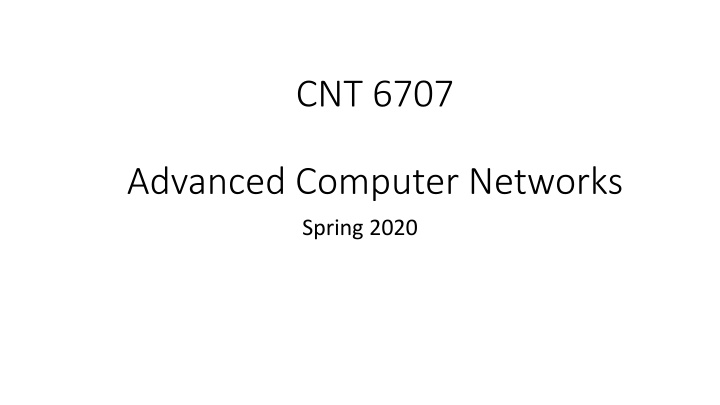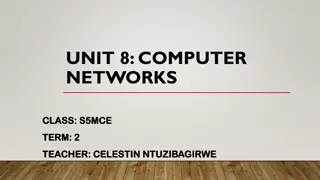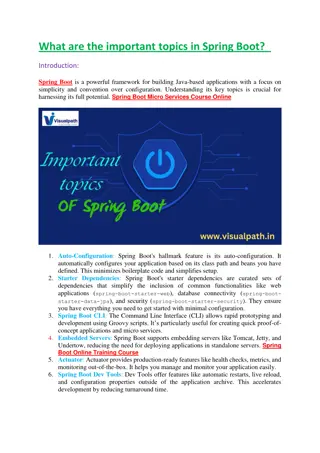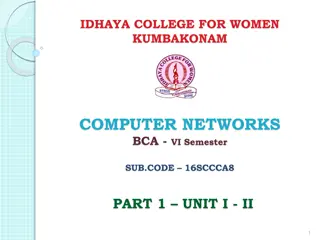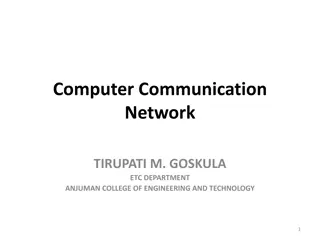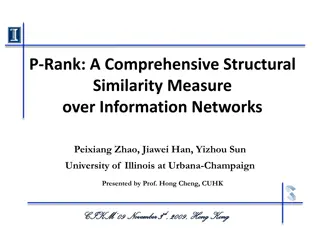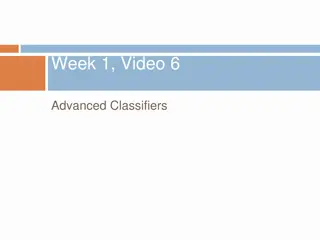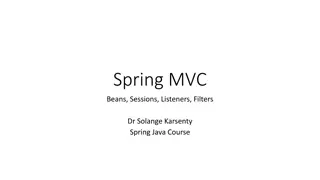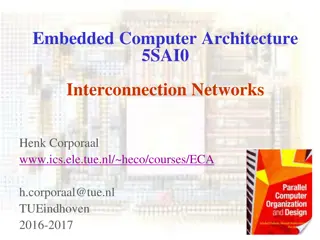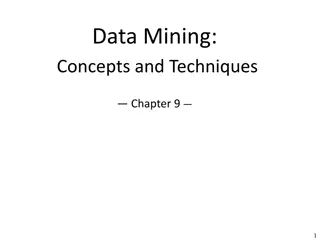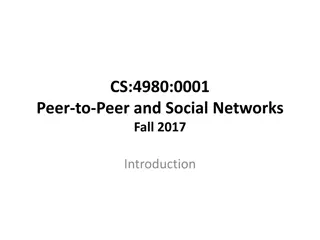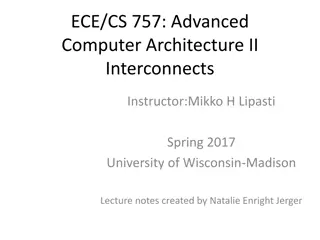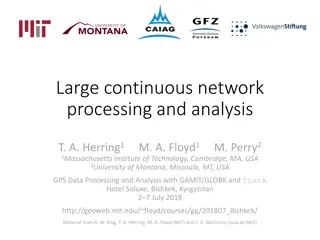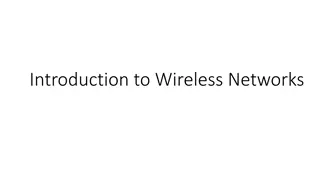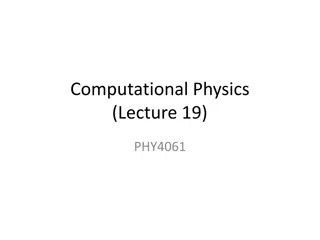Advanced Computer Networks: Spring 2020 Overview
In this class, Professor Damla Turgut covers wireless networks, IoT, and more. Requirements include basic networking knowledge at an undergraduate or introductory graduate level.
Download Presentation

Please find below an Image/Link to download the presentation.
The content on the website is provided AS IS for your information and personal use only. It may not be sold, licensed, or shared on other websites without obtaining consent from the author.If you encounter any issues during the download, it is possible that the publisher has removed the file from their server.
You are allowed to download the files provided on this website for personal or commercial use, subject to the condition that they are used lawfully. All files are the property of their respective owners.
The content on the website is provided AS IS for your information and personal use only. It may not be sold, licensed, or shared on other websites without obtaining consent from the author.
E N D
Presentation Transcript
CNT 6707 Advanced Computer Networks Spring 2020
About the instructor Prof. Damla Turgut Contact details: HEC 316, (407) 823-6171, turgut@cs.ucf.edu (preferred) Office hours: MW 10:30am-11:45am http://www.cs.ucf.edu/~turgut/ Research interests: Wireless networks (ad hoc, sensor, underwater sensor, vehicular, etc) IoT (smart home, smart healthcare, etc)
Grading Paper presentations = 40% Reviews: 25% Exam: 25% Class participation: 10%
Subject matter of the class In this class we survey the current state of the art in networking While we will cover all areas of networking, we focus in special on wireless networks IoT sensor networks edge / fog networks We will read recent papers from top conferences and journals in the field The material we cover is usually not yet in textbooks
What background do I need? You will need basic understanding of networking concepts at the level of an undergraduate class or intro graduate level class. This is not the right class if you haven t heard of IP, TCP, routing, MAC layer etc. You took at UCF: CNT 3004 or CNT 5008 you are good to go Other equivalent classes you are also good to go Equivalent knowledge acquired through other means should be probably ok.
ML and artificial intelligence A significant trend in networking is about the application of recent results in machine learning and artificial intelligence Many (but not all) the papers you need to read will have some ML/AI components. But we are still looking at the networking aspects! We won t delve deeply into the ML/AI aspects, except in the sense of using them as tools.
Do I need ML/AI expertise? No! You don t need to write AI/ML code You don t need to understand the math You might need to recognize what different ML/AI components do (e.g. classification, optimization, etc.) Many of the papers we will read were the result of a multi-disciplinary collaboration between a networking expert, an AI expert and possible domain experts In this class you are the networking expert If you took an ML and/or AI class at UCF, online or other institutions you might recognize some of the concepts
How do I read advanced networking papers? Papers at top level conferences can be challenging to read Among other things, the multidisciplinary nature means that you have sections written by different specialists Intimidating amount of math New terms and definitions
Dont panic! You don t have to understand everything.
Questions you need to understand when reading a paper Proceed systematically by reading such that we find answers to some questions These are also the same topics that your presentations should contain Origin of the paper Network setting What is being improved What is the improvement technique When is the improvement applied How was the paper evaluated? Afterlife of the paper Personal view on the contributions
Origin of the paper Where is the a paper coming from? Research lab University Company? Is the lab / authors famous? If yes, for what?
Page, Lawrence, Sergey Brin, Rajeev Motwani, and Terry Winograd. The PageRank citation ranking: Bringing order to the web. Stanford InfoLab, 1999.
Network setting These are networking papers, so there is some kind of network in the picture. What type of network the paper considers? Wired network Wireless network (wifi) Cellular network Sensor network Internet of Things (IoT) Edge/fog networks Hybrid system of multiple networks If the paper considers a specific application area such as healthcare, industrial settings etc. you want to identify it here as well.
What is being improved? Most papers provide some kind of improvement compared to the state of the art. There is a very small number of papers which introduce completely new application areas. But most new protocols etc. are introduced in order to improve some parameters within an existing application. What is the network (or other) parameter that is being improved? Bandwidth Latency Reliability Energy consumption Cost Privacy User satisfaction
What is the improvement technique? What is the technique used by the work to improve the chosen parameter(s). These will be often AI/ML techniques new network protocol (MAC, routing) Search Linear / non-linear optimization Deep neural network Game theory Genetic algorithm Other (what?) You do not need to develop an in-depth understanding of this technique But see next slide.
Discussion about the improvement technique This is where the paper might be hard to read! Also, puzzled listeners when you make your presentation If the improvement technique is not obvious, you should do at least some superficial research on it, and add 1-2 slides about it into the presentation E.g. if the technique is genetic algorithms, briefly explain what are they. Look for resources that introduce the technique for non-specialists (e.g. Wikipedia, intro classes, youtube videos, blog entries on Medium.com). Try to find the clearest, most straightforward description and summarize them on one/two slides. For instance: https://towardsdatascience.com/introduction-to-genetic-algorithms- including-example-code-e396e98d8bf3
When is the technique applied When is the improvement technique applied: Before the system is run For instance, static paths, planning techniques During runtime E.g. routing or MAC protocols After execution For instance, for analyzing the logs. A related question: where is the improvement code running On the routers, hosts, IoT devices, user desktop, cloud?
How was the paper evaluated? In order for us to believe the claims of the paper, we need to see how it was evaluated. This often involves comparison with other techniques. There are several ways to evaluate the claims: With theoretical proofs In handcrafted simulation In a publicly available simulation framework Testbed Real world deployment Related question: what does the paper compares against? Strong claim: current best techniques Weak claim: our technique is better than random
The afterlife of a paper Especially if the paper is older, it is useful to investigate its impact. For instance, the Bill Gates paper is a mathematical curiosity. Gates, William H., and Christos H. Papadimitriou. "Bounds for sorting by prefix reversal." Discrete mathematics 27, no. 1 (1979): 47-57., citations: 358 The Larry Page / Sergey Brin paper describes the algorithm which built Google. Page, Lawrence, Sergey Brin, Rajeev Motwani, and Terry Winograd. The PageRank citation ranking: Bringing order to the web. Stanford InfoLab, 1999. citations: 12,984 How do we evaluate impact? Number of citations (look it up on scholar.google.com) be aware of the publication year, new papers might not have a lot of citations Was it deployed? Where? How wide? Is it the basis of follow-up work?
Personal view What is your opinion about the paper? Do you find it impressive? Brilliant idea Impressive amount of experimental work Deep theoretical work Convincing practical application Impressive improvement Or maybe you are not impressed? Results slightly better than random? Comparison only with variations of the proposed algorithm? Proof by intimidation excessive amount of math, mostly definitions, obscuring the real problem. Contrived, unrealistic problem setting?
